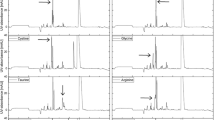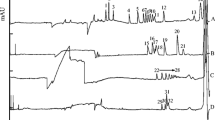Abstract
A simple and effective capillary electrophoresis (CE) method for the separation and quantification of d-allose in the presence of its process impurities, namely sucrose, d-glucose, d-fructose, d-psicose, and d-altrose, has been developed and validated. The optimum conditions for the separation with an acceptable resolution are found to be as follows: background electrolyte (BGE): 36 mM of Na2HPO4 and 130 mM NaOH; pH: 12.6; and voltage: 18 kV with direct UV detection at 265 nm. The present method overcomes the limitations of existing analytical method like sample preparation, poor resolution, and sensitivity. The method is optimized with the established standard curves for d-allose and its related impurities in the concentration range 0.25 to 3.0 mM with coefficient of determinations > 0.99 and the limit of detection (LOD) in the range of 0.11 to 0.20 mM. Separation of d-allose and its impurities present in the mixture is achieved using the current method with good resolution, linearity, and reproducibility. The present method is suitable for the analysis of the final product in the enzymatically synthesized d-allose and also for reaction monitoring of in-process samples.



Similar content being viewed by others
References
Al-Mhanna N, Huebner H, Buchholz R (2018) Analysis of the sugar content in food products by using gas chromatography mass spectrometry and enzymatic methods. Foods 7(11):185
Brummer Y, Cui SW (2004) Understanding carbohydrate analysis, food carbohydrates: chemistry, physical properties and applications. LLC, Tylor and Francis
Byung Yun Yang RM (1996) Alkaline degradation of fructofuranosides. Carbohydr Res 280:47–57
Carvalho AZ, da Silva JAF, do Lago CL (2003) Determination of mono- and disaccharides by capillary electrophoresis with contactless conductivity detection. Electrophoresis 24:2138–2143
Chari VMGBR, Harborne JB, Österdahl BG (1981) An acylated allose-containing 8-hydroxyflavone glycoside from Veronica filiformis. Phytochemistry 20:1977–1979
Chattopadhyay S, Raychaudhuri U, Chakraborty R (2014) Artificial sweeteners - a review. J Food Sci Technol 51:611–621
Chen Z, Chen J, Zhang W, Zhang T, Guang C, Mu W (2018) Recent research on the physiological functions, applications, and biotechnological production of D-allose. Appl Microbiol Biotechnol 102:4269–4278
Corradini C, Cavazza A, Bignardi C (2012) High-performance anion-exchange chromatography coupled with pulsed electrochemical detection as a powerful tool to evaluate carbohydrates of food interest: principles and applications. Int J Carbohydr Chem 13
Feil R, Lunn JE (2018) Quantification of soluble sugars and sugar alcohols by LC-MS/MS. Plant Metabol:87–100
Galant AL, Kaufman RC, Wilson JD (2015) Glucose: detection and analysis. Food Chem 188:149–160
Honda S (1996) Separation of neutral carbohydrates by capillary electrophoresis. J Chromatogr A 720:337–351
Jensen SRMC, Nielsen BJ (1981) Iridoid mono-and di-glycosides in Mentzelia. Phytochemistry 20:71–83
Kenji Morimoto, Chang-Su Park, Motofumi Ozaki, Kei Takeshita, Tsuyoshi Shimonishi, Tom Birger Granstrom, Goro Takata, Masaaki Tokuda, Ken Izumori (2006) Large scale production of d-allose from d-psicose using continuous bioreactor and separation system. Enzyme and Microbial Technology 38:855–859
Kim NH, Kim HJ, Kang DI, Jeong KW, Lee JK, Kim Y, Oh DK (2008) Conversion shift of D-fructose to D-psicose for enzyme-catalyzed epimerization by addition of borate. Appl Environ Microbiol 74:3008–3013
Leang K, Takada G, Ishimura A, Okita M, Izumori K (2004) Cloning, nucleotide sequence, and overexpression of the L-rhamnose isomerase gene from Pseudomonas stutzeri in Escherichia coli. Appl Environ Microbiol 70:3298–3304
Li Z, Gao Y, Nakanishi H, Gao X, Cai L (2013) Biosynthesis of rare hexoses using microorganisms and related enzymes. Beilstein J Org Chem 9:2434–2445
Luis AC, Dadoo R, Zare RN (1993) Determination of carbohydrates by capillary zone electrophoresis with amperometric detection at a copper microelectrode. Anal Chem 65:476–481
Mantovani V, Galeotti F, Maccari F, Volpi N (2018) Recent advances in capillary electrophoresis separation of monosaccharides, oligosaccharides, and polysaccharides. Electrophoresis 39:179–189
Menavuvu BT, Poonperm W, Leang K, Noguchi N, Okada H, Morimoto K, Granstrom TB, Takada G, Izumori K (2006) Efficient biosynthesis of D-allose from D-psicose by cross-linked recombinant L- rhamnose isomerase: separation of product by ethanol crystallization. J Biosci Bioeng 101:340–345
O’Neil MHP, Koch C, Roman K (2006) The Merck index: an encyclopedia of chemicals, drugs, and biologicals, vol 46, 14th edn. Merck & Co. Inc, Whitehouse Station, p 78
Oefner PJ, Vorndran AE, Grill E, Huber C, Bonn GK (1992) Direct UV detection of carbohydrates in capillary zone electrophoresis. Chromatographia 33:3–4
Oshima H, Kimura I, Izumori K (2006) Psicose contents in various food products and its origin. Food Sci Technol Res 12:137–143
Park CS, Yeom SJ, Kim HJ, Lee SH, Lee JK, Kim SW, Oh DK (2007) Characterization of ribose-5- phosphate isomerase of Clostridium thermocellum producing D-allose from D-psicose. Biotechnol Lett 29:1387–1391
Paulus AKA (1996) Detection of carbohydrates in capillary electrophoresis. J Chromatogr A 720:353–376
Perold GW, Beylis P, Howard AS (1973) Metabolites of proteaceae. 8. The occurrence of (+)-D-allose in nature: rubropilosin and pilorubrosin from Protea rubropilosa Beard Journal of the Chemical Society. Perkin Trans 6:643–649
Ragupathi Raja Kannan R, Arumugam R, Anantharaman P (2012) Chemical composition and antibacterial activity of Indian seagrasses against urinary tract pathogens. Food Chem 135:2470–2473
Roig OTB (2003) Rapid estimation of global sugars by UV photodegradation and UV spectrophotometry. Anal Chim Acta 477:325–329
Rovio S, Yli-Kauhaluoma J, Siren H (2007) Determination of neutral carbohydrates by CZE with direct UV detection. Electrophoresis 28:3129–3135
Rovio S, Simolin H, Koljonen K, Siren H (2008) Determination of monosaccharide composition in plant fiber materials by capillary zone electrophoresis. J Chromatogr A 1185:139–144
Sithara R, Selvakumar P, Arun C, Anandan S, Sivashanmugam P (2017) Economical synthesis of silver nanoparticles using leaf extract of Acalypha hispida and its application in the detection of Mn(II) ions. J Adv Res 8:561–568
Surapureddi SRK, Kunta R, Sameer Kumar GS, Sappidi SR, Dadke S (2019) A sensitive and high throughput method for the analysis of d-psicose by capillary electrophoresis. Food Chem 281:36–40
Surapureddi SRK, Kunta R, Saritha A (2020) A HPLC tool for process monitoring: rare sugar D- psicose and D- fructose contents during the production through an enzymatic path. Int J Res Pharm Sci 11(1):775–780
Takeshita K, Suga A, Takada G, Izumori K (2000) Mass production of D-psicose from d-fructose by a continuous bioreactor system using immobilized D-tagatose 3-epimerase. J Biosci Bioeng 90:53–455
Terami Y, Uechi K, Nomura S, Okamoto N, Morimoto K, Takata G (2015) Production of L-allose and D-talose from L-psicose and D-tagatose by L-ribose isomerase. Biosci Biotechnol Biochem 79:1725–1729
Warren CR, Adams MA (2000) Capillary electrophoresis for the determination of major amino acids and sugars in foliage: application to the nitrogen nutrition of Sclerophyllous species. J Exp Bot 51:1147–1157
Weckwerth W, Loureiro ME, Wenzel K, Fiehn O (2004) Differential metabolic networks unravel the effects of silent plant phenotypes. Proc Natl Acad Sci U S A 101:7809–7814
Zhao L, Chanon AM, Chattopadhyay N, Dami IE, Blakeslee JJ (2016) Quantification of Carbohydrates in grape tissues using capillary zone electrophoresis. Front Plant Sci 7:818
Acknowledgments
We thank Koneru Lakshmaiah Education Foundation, Green Fields, Vaddeswaram, Guntur District, Andhra Pradesh, and the Management of Vimta labs, Hyderabad, for providing us the necessary facilities to carry out this work. We thank Dr. U. Satyanarayana, senior marketing manager, Waters India Pvt Ltd., Hyderabad, India, for his constant guidance and critical suggestions while the work is in progress.
Author information
Authors and Affiliations
Contributions
SRKS and KR designed and executed the experiments.
SR analyzed the data and drafted the manuscript.
GSSK and SR drafted the manuscript.
SRKS, KR, and SRS helped in providing scientific and technical inputs, interpreting the data, and reviewing the manuscript.
Corresponding author
Ethics declarations
Conflict of Interest
Sri Rama Krishna Surapureddi declares no conflict of interest. Kunta Ravindhranath declares no conflict of interest. Ghantasala S Sameer Kumar declares no conflict of interest. Sreedhar Reddy Sappidi declares no conflict of interest.
Ethical Approval
All procedures performed in the present investigation were in accordance with the ethical standards of the national and institutional norms.
Informed Consent
Informed consent is not applicable.
Additional information
Publisher’s Note
Springer Nature remains neutral with regard to jurisdictional claims in published maps and institutional affiliations.
Rights and permissions
About this article
Cite this article
Surapureddi, S.R.K., Ravindhranath, K., Sameer Kumar, G.S. et al. Separation and Determination of d-Allose in Presence of Process-Related Impurities by Capillary Electrophoresis. Food Anal. Methods 13, 2269–2278 (2020). https://doi.org/10.1007/s12161-020-01842-z
Received:
Accepted:
Published:
Issue Date:
DOI: https://doi.org/10.1007/s12161-020-01842-z




